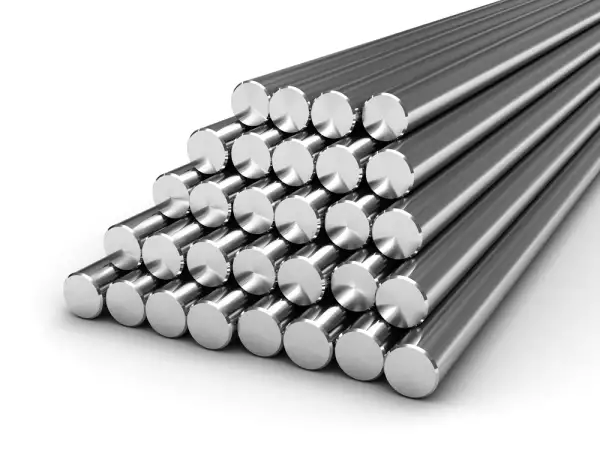From the series of articles "Lightning protection for beginners".
It is very simple to invent a lightning rod. Lightning is only a long spark that breaks through a layer of air, that is a very high-quality insulator. The thicker the layer is, the harder it is to break. So you need to help the lightning, reducing the length of the insulating gap. This is made by the metal pin of the lightning rod. We omit all the "small things" like proof of electrical nature of lightning, or quite an unsafe experiment with the launch of a kite into a storm cloud. They cost a lot to B. Franklin. Fortunately for him there was no wire in the kite, but a thin thread tissue. Even having become wet, it was a very mediocre conductor. Otherwise Franklin's name would have been put in the same row with G. Richmann - the first victim among the famous lightning researchers. His bust is standing on one of the streets of Pärnu in Estonia, where he was born.
It was two and a half centuries ago. In principle, the lightning rod has not changed. It's all the same grounded rod electrode on the buildings or around them, and on power lines - it's a horizontal ground conductor, suspended above the high-voltage wires. It is clear that for reliable operation lightning rod must rise over the protected structure. The question, how much higherwas tried to be solved only in the middle of the last century. The researchers again used the analogy between a long spark and lightning. A model of the protected building and a model of its lightning rod were put in a high-voltage hall. A spark 1 - 5 meters long played the role of lightning.
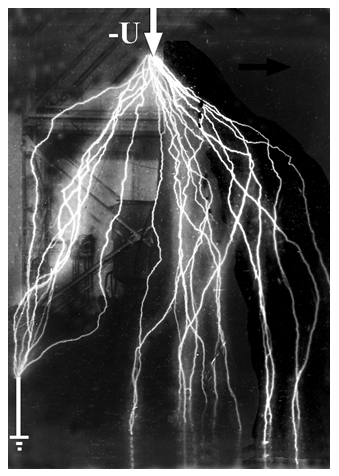
Fig. 1. Here is the picture of many spark channels during the testing of the lightning rod model
Having performed hundreds of experiments, it was possible to see how many sparks were caught by the lightning rod, how many hit the ground, and what is the percentage of those that still broke through to the protected object. The very first protection zones of lightning rods were built so. The zone border limited the protected area in the vicinity of the lightning rod. It was distinguished by the fact that any object, located entirely inside the zone, was struck by lightning with a probability of not greater than the one specified.
Protection zones are introduced into the regulations of many countries, including Russia. There are two sets of zones at the same time for Russia. Their reliability is not specifically designated in the normative document "Instructions for lightning protection of buildings and structures of AD 34.21.122-87". It only says that the reliability of zone A is higher than that of the zone B. In a new normative document of 2003 "Instructions for lightning protection of buildings, structures and industrial communications" the protection zones have been attributed with a very specific reliability: 0.9, 0.99, or 0.999. It is easy to decrypt these nines. When the reliability is 0.9, one lightning out of 10 will break through to the protected object, with the reliability of 0.999 - one out of thousand.
The transition to a probabilistic estimate means that one should not count on the perfect lightning rod, like you don't have to think about a perfectly reliable car or ever serving shoes. Any technical means is limited in its capabilities and a lightning conductor is not an exception.
Then it is reasonable to put a simple question - how to determine the reliability of a lightning rod? The answer seems obvious. It is necessary to organize monitoring over the various facilities protected by lightning rods. It is easy to imagine how much it will cost. A tower or a pillar, say, 30m high, mounted in the central part of Russia, will undertake an average of about 1 lightning strike in 15 years of operation. In order to somehow evaluate protection reliability at the level of 0,999 , it is required to track not less than 1000 lightning. This will require about 15 000 years. A rare experimenter would agree to that. The observation time can be reduced by increasing the number of the observed objects. In reality, it will require at least several hundreds, which will cost a lot of effort and money.
A specialist will tell you that in fact the resulting assessment will have to be increased many tens of times, because the above-ground structures and lightning rods are of very different height. It will be necessary to track all of their diversity.
It's time for a critical reader to reproach me, reminding me about a laboratory simulation. Replacing lightning with a long spark, you can get the necessary statistics incomparably faster. The gain in speed does not cause doubt, but it is impossible to say the same about the results of the laboratory tests. By the present time, they are performed with sparks of up to 30 meters. Unfortunately we haven't got unambiguous results. The probability of a lightning break by a lightning rod model to the model of the protected object was dependent on the model and size, and on the voltage growth rate in the discharge gap, in which the model is installed. Laboratory simulation is useful for a qualitative comparison of different types of lightning rods, but the accuracy of the quantitative estimations of protection reliability causes big doubts.
The situation arising in lightning protection is extremely favorable to all sorts of speculation. They did not keep us waiting. It is hardly necessary to study all the diversity of dashing methodological constructions that have been accumulated by today, but none of them can be missed. rolling sphere method is not simply known to most designers, it is included into the lightning protection standard of the International Electrotechnical Commission (IEC) 62305. The Russian State Standard has already translated two volumes of this standard, and published them under the name of GOST-R. The third volume with the rolling sphere is coming. For me, it is more scary than the monsters from the etchings of Goya.
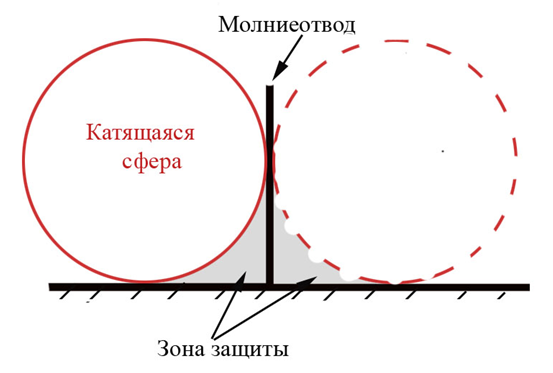
Fig. 2. Rolling sphere method
Молниеотвод – lightning rod
Катящаяся сфера – rolling sphere
Зона защиты – protection zone
The method is not only easy, but even elegant. You have a sphere of a strictly specified radius at your disposal. It must be put against a lightning rod, as shown in the figure, and roll around it. All that is under the boundary of the trace of the rolling sphere is protected against lightning (Fig. 2). The rest is not. There can be several lightning rods. Then the rolling sphere can rely on them one by one, rolling around the protected area, in which the protected object should be placed. The IEC standard specifies the values of the rolling sphere radius: 20 m, 30 m, 45 m to 60 m for I, II, III and IV levels of protection, guaranteeing reliability respectively 0.98, 0.95, 0.9 and 0.8.. I would like to know where these values came from. There is complete silence in the scientific literature and in the standard about that. It is impossible to get to the basics of the method, although it is very desirable. Quantitative analysis is not available here. We have to rely on high-quality conformities, learned from many years of operating experience and spark discharge theory.
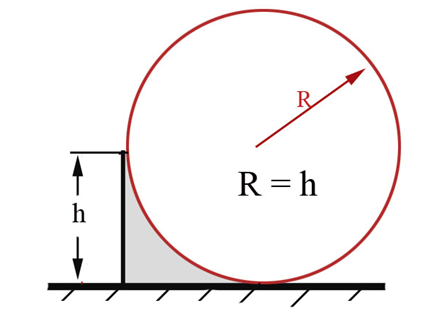
Fig. 3. The first consequence of the rolling sphere method
In fig. 3 a lightning rod, the height of which is equal to the radius of the rolling sphere for a given level of reliability. The sphere rolls over a conical surface, which should be considered as a border of the lightning rod protection zone. Look, it starts directly from its top. That means, a closely located lightning rod cab project an object with high reliability without any significant excess. The absurdity of this result from the rolling sphere method is easy to be checked at least in the laboratory. It is enough to set two bars of equal height close by, marking one of them with the letter L (lightning rod), another letter with O (object). Now you have to subject the structure to long sparks and count the number of strikes in each of the rods. At the equal height, the result will be obvious - equally. The advantage of a lightning rod can only come to light when its height is increased.
The first is absurdity is obvious. And in fact, generally speaking, it is enough to discredit the method. Nevertheless, I can not give up demonstration of a more convincing absurdity. We will increase the height of the lightning rod, making it larger than the radius of the rolling sphere. The protection zone won't increase because of that, neither will the protection reliability - it's a complete contradiction to the operating experience! You can rise a lightning rod even to the level of the Tower of Babel. For the rolling sphere, this should not lead to a positive effect. The enthisiasts of the common market are desperately trying to introduce this calculation method of lightning rods in the territory of Russia.
Now it's time to talk about the domestic practice of the choice of lightning rods. The main principle is firm here. Any lightning conductor is able to provide only the final protecton reliability. With any number of "nines", it is certainly less than one. This is due to the quirkiness of the lightning trajectory (and long spark too). It doesn't always matcg Franklin's ideas about the motion at the shortest distance. I cannot help but show you two photos, which were probably published in hundreds of different editions. The first of them was received by the specialists of the Energy
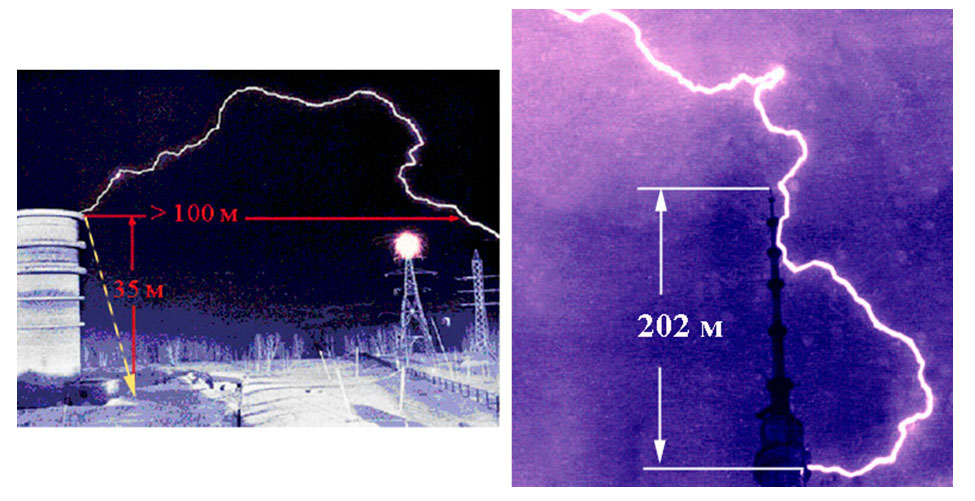
Fig. 4. The quiriness of long spark and lightning trajectories
Institute to the name of G.M. Krzyzanowski at the Ostankino TV tower. The lightning missed 202 meters to the peak! The second photo was made during the experiments on a high-voltage stand at the Siberian research institute of electric power industry. The cylindrical tower in the picture is a high-voltage generator of about 35 meters high. The long spark launched from its top at the voltage of about 5 MW, but instead of the shortest path to the ground it chose a flight to the high-voltage power line at the distance of more than 100 m..
It seems that not only the microworld is subject to the probability laws. Statistical description has to be used for the lightning trajectories. It is impossible to predict the path of a particular lightning. Only the probability of its occurrence in a particular place, defined for a particular series of many electric discharges can be calculated. The national calculation method is reasonably called statistical. It estimated the probabilities of two events. At first, the probability of lightning orientation is calculated in the direction of a system of ground objects (it can be a collection of structures and lightning rods protecting them), and then the issue of choosing the point of impact oriented by lightning - on the surface of one of the lightning rods or on the protected object is solved. The calculations contain geometric dimensions of lightning rods and objects, and most importantly - two statistical parameters, standards of orientation and selection that determine the possible limits of the trajectories' range. Their correct definitoon is a very big problem. Statistics accumulated during the operation of lightning rods is used to solve it. First of all, statistics of ground wires on the transmission lines.
Although the observations have been held for more than half a century, the collected data is not too impressive and relates to a fairly narrow range of heights (generally 20 - 40 m). Therefore, the absolute reliability of statistical techniques is out of the question. In the best case, the assessment at the level of 0.999 can be justified. In contrast to the rolling sphere method, statistical technique does not bring to absurd consequences. In any case, it requires that the lightning arrester woud necessarily exceed the protected object under the protection reliability of more than 0.5. Please, take a look, at the protection zone of a single lightning rod of 30 m high, built according to the statistical methodology. With the protection reliability of 0.9 it starts not from the top of the lightning rod, but 15% lower; with the reliability of 0.999 - 30% lower. The effect of increasing the protection reliability with the increase of lightning rod heigh easily fits the statistic method.
Here is the place to talk about a not very useful habit of national designers of lightning protection. They prefer to choose lightning rods according to protection zones. It is easy to draw a typical zone. There is a set of basic formulas in the regulatory documents for that, and on the internet there are a lot of simple calculation programs with nice, though useless pictures. It remains to check whether the protected object fits the internal volume of the zone in the drawing. If yes, the protection will be provided. Now, about the dangers of such practices.
When the Cathedral of Christ the Savior was being reconstructed in Moscow, the designers took into account that with its considerable height almost annual lightning strikes can be expected. It is possible that the strike will happen on a holiday, with a large crowd of people on the porch. To ensure the safety of the parishioners it was necessary to ensure spreading of the lightning current over a very extensive system of underground buses, thereby minimizing step voltages.
In many real-life situations, the project for protection zones will be excessive. The object rarely fills the whole zone object and often many construction elements are placed far enough away from the border. In this situation, the actual protection reliability can be much higher than required, but the designer can not know how higher. Secondly, protection zone can be constructed only for one type of lightning rods (rod or catenary wire), and either single or double and necessarily of equal height. Thereby their range is drastically limited, and hence the possibility of selecting the optimal system of lightning rods. It is useful to give a few examples to assess how serious losses can be. Software developed by the statistical method is good for that purpose. Let a large tank 20 m high and with a diameter of 60 m be a protected object. We assume that the technical specifications do not allow installation of lightning rods at the distance closer than 20 meters from the tank. Calculated data in fig. 5 shows how the probability of a lightning break to the tank changes depending on the height and the number of lightning rods. The difference between a single lightning rod 100 meters high and four lightning rods 28 m eacg is too serious to ignored possible metal and money savings. In fact, the transition to the use of multiple lightning rods in practice means the possibility of failure from the design and installation of high-rise buildings and the use of standard commercially available lightning rods,the installation of which does not present any particular problem.
But these are not all benefits. In previous articles I said that the number of lightning strikes increases with the height of the building. For example, for single structures of small area (masts, lightning rods), the dependence on the height of the construction is square. It means a rod lightning rod of 110 m will ctake upon itself about 10 times more lightning strikes than the 28-meter
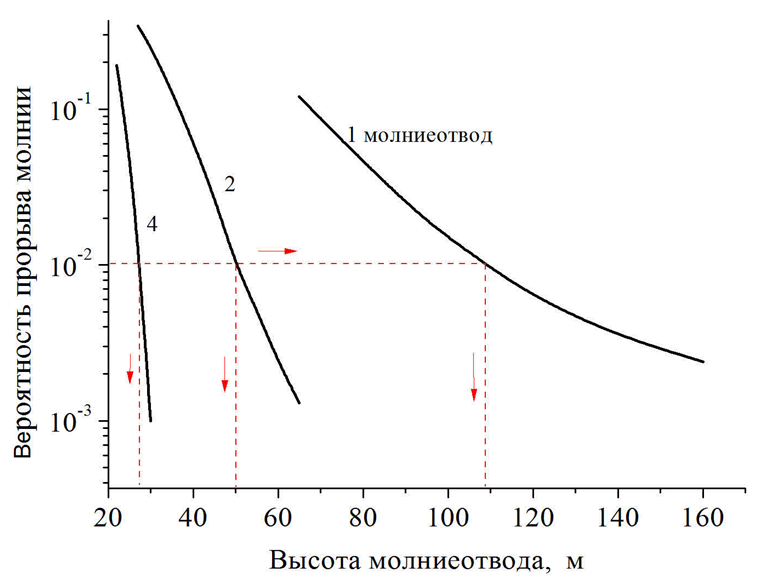
Fig. 5. Estimation of advantages of multiple lightning rods
construction. This is very useful to limit the number of dangerous electromagnetic interferences on the control circuit and automation of the protected object.
Can we consider the problem of lightning rod design solved? Unfortunately, the answer is no. Modern technology requires not only reliable lightning rods and those that can be installed at a respectful distance from the object to be protected. In this case, lightning current in the metal structures of the lightning rod won't be able to create strong electromagnetic interferences, dangerous for the internal circuits of the object. Today, this task is one of the most important. Its solution is to come.
E. M. Bazelyan, DEA, professor
Energy Institute named after G.M. Krzyzanowski, Moscow
We hope that in the future this site will perform the role of an elementary textbook for self-defense against lightning. We plan to continually post articles about the real dangers of lightning electricity and modern means of lightning protection here. They are designed to help to sort out the existing problems and to estimate the ways to solve it.
See also:
- Free webinars for project designers with Professor E.M. Bazelyan
- Free webinars for project designers with Dr. M. Loboda
- A series of articles "Lightning protection of oil and gas facilities"
- A series of articles "Lightning protection of residential and public buildings"
- Grounding in lightning protection - answers to frequently asked questions in the design
- Consultations on the selection, design and installation of grounding and lightning protection systems
Related Articles:
 Grounding in the cellar of the single-family house - is it possible?
Grounding in the cellar of the single-family house - is it possible?


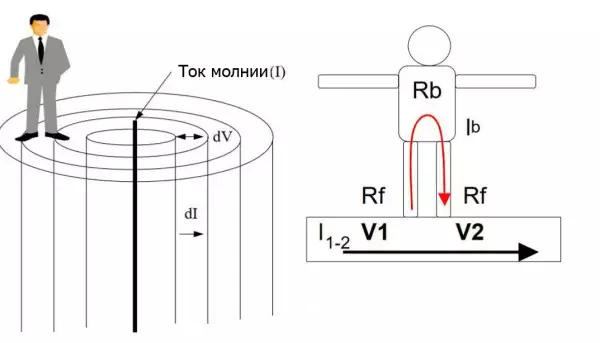 Step Voltage: Dangerous Obscurity and Reliable Protection
Step Voltage: Dangerous Obscurity and Reliable Protection
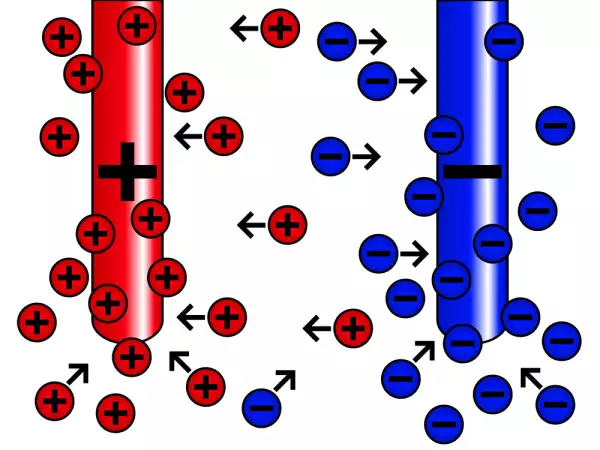 Nature of Electrochemical Corrosion
Nature of Electrochemical Corrosion
 Public Safety in Land Transport in case of Direct Lightning Strike
Public Safety in Land Transport in case of Direct Lightning Strike
